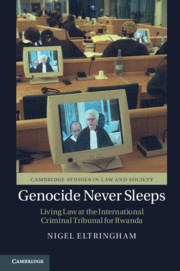Book contents
- Genocide Never Sleeps
- Cambridge Studies in Law and Society
- Genocide Never Sleeps
- Copyright page
- Contents
- Figures
- Acknowledgements
- Introduction: Judging the Crime of Crimes
- 1 ‘When We Walk Out; What Was It All About?’
- 2 ‘Watching the Fish in the Goldfish Bowl’
- 3 ‘Who the Hell Cares How Things Are Done in the Old Country’
- 4 ‘They Don’t Say What They Mean or Mean What They Say’
- 5 ‘We Are not a Truth Commission’
- Conclusion
- Bibliography
- Index
- Cambridge Studies in Law and Society
2 - ‘Watching the Fish in the Goldfish Bowl’
Published online by Cambridge University Press: 03 September 2019
- Genocide Never Sleeps
- Cambridge Studies in Law and Society
- Genocide Never Sleeps
- Copyright page
- Contents
- Figures
- Acknowledgements
- Introduction: Judging the Crime of Crimes
- 1 ‘When We Walk Out; What Was It All About?’
- 2 ‘Watching the Fish in the Goldfish Bowl’
- 3 ‘Who the Hell Cares How Things Are Done in the Old Country’
- 4 ‘They Don’t Say What They Mean or Mean What They Say’
- 5 ‘We Are not a Truth Commission’
- Conclusion
- Bibliography
- Index
- Cambridge Studies in Law and Society
Summary
As discussed in the Introduction, scholarship on international criminal justice has tended to concentrate on texts (judgments and transcripts). These texts are, however, a residue of dynamic, situated encounters (see Buur, 2003b: 67; Robben, 2010). As the episode above illustrates, the courtroom is a place in which people occupy specific positions, sweat and expend energy. Such details have been largely absent from scholarly literature on the ICTR (on the Extraordinary Chambers of the Courts of Cambodia, see Hinton 2016: 47–8, 229–32, 254–5).
- Type
- Chapter
- Information
- Genocide Never SleepsLiving Law at the International Criminal Tribunal for Rwanda, pp. 56 - 83Publisher: Cambridge University PressPrint publication year: 2019

